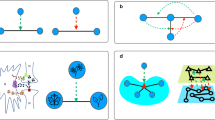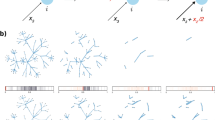Abstract
The function of a real network depends not only on the reliability of its own components, but is affected also by the simultaneous operation of other real networks coupled with it. Whereas theoretical methods of direct applicability to real isolated networks exist, the frameworks developed so far in percolation theory for interdependent network layers are of little help in practical contexts, as they are suited only for special models in the limit of infinite size. Here, we introduce a set of heuristic equations that takes as inputs the adjacency matrices of the layers to draw the entire phase diagram for the interconnected network. We demonstrate that percolation transitions in interdependent networks can be understood by decomposing these systems into uncoupled graphs: the intersection among the layers, and the remainders of the layers. When the intersection dominates the remainders, an interconnected network undergoes a smooth percolation transition. Conversely, if the intersection is dominated by the contribution of the remainders, the transition becomes abrupt even in small networks. We provide examples of real systems that have developed interdependent networks sharing cores of ‘high quality’ edges to prevent catastrophic failures.
This is a preview of subscription content, access via your institution
Access options
Subscribe to this journal
Receive 12 print issues and online access
$209.00 per year
only $17.42 per issue
Buy this article
- Purchase on Springer Link
- Instant access to full article PDF
Prices may be subject to local taxes which are calculated during checkout




Similar content being viewed by others
References
Stauffer, D. & Aharony, A. Introduction to Percolation Theory (Taylor and Francis, 1991).
Kirkpatrick, S. Percolation and conduction. Rev. Mod. Phys. 45, 574–588 (1973).
Berkowitz, B. Analysis of fracture network connectivity using percolation theory. Math. Geol. 27, 467–483 (1995).
Pastor-Satorras, R. & Vespignani, A. Epidemic spreading in scale-free networks. Phys. Rev. Lett. 86, 3200–3203 (2001).
Newman, M. E. Spread of epidemic disease on networks. Phys. Rev. E 66, 016128 (2002).
Albert, R., Jeong, H. & Barabási, A-L. Error and attack tolerance of complex networks. Nature 406, 378–382 (2000).
Cohen, R., Erez, K., Ben-Avraham, D. & Havlin, S. Resilience of the Internet to random breakdowns. Phys. Rev. Lett. 85, 4626–4628 (2000).
Callaway, D. S., Newman, M. E., Strogatz, S. H. & Watts, D. J. Network robustness and fragility: Percolation on random graphs. Phys. Rev. Lett. 85, 5468–5471 (2000).
Dorogovtsev, S. N., Goltsev, A. V. & Mendes, J. F. Critical phenomena in complex networks. Rev. Mod. Phys. 80, 1275–1335 (2008).
Bollobás, B. et al. Percolation on dense graph sequences. Ann. Prob. 38, 150–183 (2010).
Karrer, B., Newman, M. E. J. & Zdeborová, L. Percolation on sparse networks. Phys. Rev. Lett. 113, 208702 (2014).
Hamilton, K. E. & Pryadko, L. P. Tight lower bound for percolation threshold on an infinite graph. Phys. Rev. Lett. 113, 208701 (2014).
Cohen, R., Havlin, S. & Ben-Avraham, D. Efficient immunization strategies for computer networks and populations. Phys. Rev. Lett. 91, 247901 (2003).
Moreira, A. A., Andrade, J. S. Jr, Herrmann, H. J. & Indekeu, J. O. How to make a fragile network robust and vice versa. Phys. Rev. Lett. 102, 018701 (2009).
Schneider, C. M., Moreira, A. A., Andrade, J. S., Havlin, S. & Herrmann, H. J. Mitigation of malicious attacks on networks. Proc. Natl Acad. Sci. USA 108, 3838–3841 (2011).
Buldyrev, S. V., Parshani, R., Paul, G., Stanley, H. E. & Havlin, S. Catastrophic cascade of failures in interdependent networks. Nature 464, 1025–1028 (2010).
Radicchi, F. & Arenas, A. Abrupt transition in the structural formation of interconnected networks. Nature Phys. 9, 717–720 (2013).
Szell, M., Lambiotte, R. & Thurner, S. Multirelational organization of large-scale social networks in an online world. Proc. Natl Acad. Sci. USA 107, 13636–13641 (2010).
Barthélemy, M. Spatial networks. Phys. Rep. 499, 1–101 (2011).
De Domenico, M., Solé-Ribalta, A., Gómez, S. & Arenas, A. Navigability of interconnected networks under random failures. Proc. Natl Acad. Sci. USA 111, 8351–8356 (2014).
Gao, J., Buldyrev, S. V., Stanley, H. E. & Havlin, S. Networks formed from interdependent networks. Nature Phys. 8, 40–48 (2012).
Son, S-W., Bizhani, G., Christensen, C., Grassberger, P. & Paczuski, M. Percolation theory on interdependent networks based on epidemic spreading. Europhys. Lett. 97, 16006 (2012).
Radicchi, F. Driving interconnected networks to supercriticality. Phys. Rev. X 4, 021014 (2014).
Reis, S. D. et al. Avoiding catastrophic failure in correlated networks of networks. Nature Phys. 10, 762–767 (2014).
Hashimoto, K-i. Automorphic Forms and Geometry of Arithmetic Varieties 211–280 (Kinokuniya Company Ltd., 1989).
Krzakala, F. et al. Spectral redemption in clustering sparse networks. Proc. Natl Acad. Sci. USA 110, 20935–20940 (2013).
Hu, Y. et al. Percolation of interdependent networks with intersimilarity. Phys. Rev. E 88, 052805 (2013).
Cellai, D., López, E., Zhou, J., Gleeson, J. P. & Bianconi, G. Percolation in multiplex networks with overlap. Phys. Rev. E 88, 052811 (2013).
Min, B., Lee, S., Lee, K-M. & Goh, K-I. Link overlap, viability, and mutual percolation in multiplex networks. Chaos Solitons Fractals 72, 49–58 (2015).
Melnik, S., Hackett, A., Porter, M. A., Mucha, P. J. & Gleeson, J. P. The unreasonable effectiveness of tree-based theory for networks with clustering. Phys. Rev. E 83, 036112 (2011).
Schneider, C. M., Araújo, N. A. M. & Herrmann, H. J. Algorithm to determine the percolation largest component in interconnected networks. Phys. Rev. E 87, 043302 (2013).
Hwang, S., Choi, S., Lee, D. & Kahng, B. Efficient algorithm to compute mutually connected components in interdependent networks. Phys. Rev. E 91, 022814 (2015).
Pittel, B., Spencer, J. & Wormald, N. Sudden emergence of a giant k-core in a random graph. J. Comb. Theory B 67, 111–151 (1996).
Nagler, J., Levina, A. & Timme, M. Impact of single links in competitive percolation. Nature Phys. 7, 265–270 (2011).
Bianconi, G. & Dorogovtsev, S. N. Percolation in networks of networks with random matching of nodes in different layers. Preprint at http://arXiv.org/abs/1411.4160 (2014).
Stark, C. et al. Biogrid: A general repository for interaction datasets. Nucleic Acids Res. 34, D535–D539 (2006).
De Domenico, M., Porter, M. A. & Arenas, A. Muxviz: A tool for multilayer analysis and visualization of networks. J. Complex Netw. 3, 159–176 (2015).
Guimerà, R., Mossa, S., Turtschi, A. & Amaral, L. N. The worldwide air transportation network: Anomalous centrality, community structure, and cities’ global roles. Proc. Natl Acad. Sci. USA 102, 7794–7799 (2005).
Colizza, V., Barrat, A., Barthélemy, M. & Vespignani, A. The role of the airline transportation network in the prediction and predictability of global epidemics. Proc. Natl Acad. Sci. USA 103, 2015–2020 (2006).
TranStats (United States Department of Transportation, accessed 18 January 2015); http://www.transtats.bts.gov
Acknowledgements
The author thanks C. Castellano and A. Flammini for comments and suggestions.
Author information
Authors and Affiliations
Corresponding author
Ethics declarations
Competing interests
The author declares no competing financial interests.
Supplementary information
Supplementary Information
Supplementary Information (PDF 592 kb)
Rights and permissions
About this article
Cite this article
Radicchi, F. Percolation in real interdependent networks. Nature Phys 11, 597–602 (2015). https://doi.org/10.1038/nphys3374
Received:
Accepted:
Published:
Issue Date:
DOI: https://doi.org/10.1038/nphys3374
This article is cited by
-
Robustness and resilience of complex networks
Nature Reviews Physics (2024)
-
The dynamic nature of percolation on networks with triadic interactions
Nature Communications (2023)
-
Interdependent superconducting networks
Nature Physics (2023)
-
A secure and robust multilayer network with optimum inter layer links under budget constraints
Multimedia Tools and Applications (2022)
-
Scaling electrical percolation networks based on renormalization group theory
Applied Physics A (2022)



